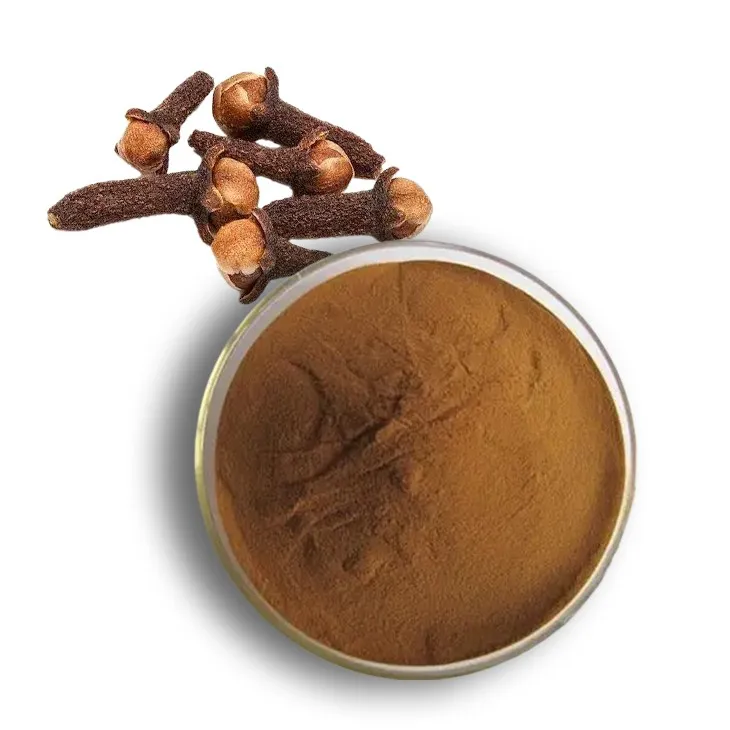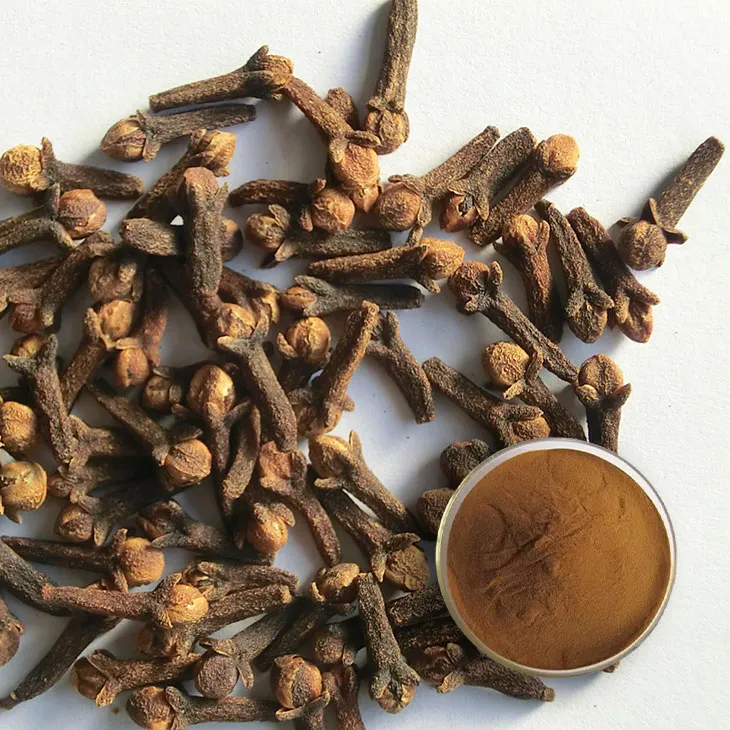- 0086-571-85302990
- sales@greenskybio.com
The process of extracting eugenol from clove powder.
2024-11-26

1. Introduction
Clove, a well - known spice, is rich in eugenol, which has a wide range of applications in various fields such as medicine, food, and cosmetics. Eugenol is a phenolic compound with a characteristic spicy and warm aroma. Extracting eugenol from Clove Powder is an important process that can make full use of the valuable components in cloves.

2. Preparation of Clove Powder
2.1 Selection of Cloves
High - quality cloves should be selected as the raw material. The cloves should be intact, without mildew or damage. Fresh cloves are often preferred as they tend to have a higher content of eugenol.2.2 Drying
If the selected cloves are not completely dry, they need to be dried. Drying can be carried out in a natural environment with good ventilation or in a drying oven at a low temperature (usually around 40 - 50°C). This step is important to prevent the growth of microorganisms during the subsequent extraction process.2.3 Grinding
After drying, the cloves are ground into powder. A grinder can be used for this purpose. The powder should be fine enough to ensure good contact with the extraction solvent in the later extraction process. The fineness of the powder can be adjusted according to the specific extraction equipment and requirements, generally, a particle size of 40 - 60 mesh is suitable.
3. Solvent Extraction
3.1 Selection of Solvents
- Ethanol: Ethanol is a commonly used solvent for eugenol extraction. It has good solubility for eugenol and is relatively safe and easy to obtain. The concentration of ethanol can be adjusted according to needs, usually, 70 - 95% ethanol is used. - Ethyl Acetate: Ethyl acetate also has a certain solubility for eugenol. It has a lower boiling point compared to ethanol, which is beneficial for the subsequent separation process. However, it is more flammable and requires more careful handling. - Other Solvents: Some other solvents such as hexane can also be considered, but they may have different selectivity and solubility for eugenol, and may also bring more complex separation problems.3.2 Extraction Process
1. Place the Clove Powder in a suitable extraction vessel, such as a Soxhlet extractor or a simple glass flask. 2. Add the selected solvent to the vessel. The ratio of the solvent to the clove powder is usually in the range of 5:1 - 10:1 (volume/mass). 3. For Soxhlet extraction, the extraction process can be carried out continuously for a certain period, usually 4 - 8 hours. During this process, the solvent is continuously refluxed through the clove powder, effectively dissolving the eugenol. 4. In the case of simple flask extraction, the mixture can be stirred continuously at a certain temperature (usually room temperature to 60°C) for 2 - 4 hours to ensure sufficient contact between the solvent and the clove powder.
4. Separation of the Extract
4.1 Filtration
After the extraction is completed, the mixture needs to be filtered to separate the solid clove powder residue from the liquid extract containing eugenol. A filter paper or a Buchner funnel with a filter membrane can be used for filtration. The filtrate obtained is the primary extract containing eugenol and the solvent.4.2 Evaporation
The filtrate is then subjected to evaporation to remove the solvent. If ethanol or ethyl acetate is used as the solvent, evaporation can be carried out at a relatively low temperature under reduced pressure. This helps to avoid the decomposition of eugenol due to high temperature. The evaporation process continues until most of the solvent is removed, and a concentrated eugenol - rich residue is obtained.5. Purification of Eugenol
5.1 Distillation
Distillation can be further carried out to purify eugenol. Since eugenol has a relatively specific boiling point (around 250 - 255°C), it can be separated from other impurities with different boiling points through distillation. A fractionating column can be used in the distillation process to improve the separation efficiency.5.2 Chromatographic Separation
- Column Chromatography: Column chromatography can also be used for the purification of eugenol. A suitable stationary phase, such as silica gel, can be filled in the column. The extract is loaded onto the column, and different components are separated by eluting with an appropriate mobile phase. Eugenol can be collected as a pure fraction. - High - Performance Liquid Chromatography (HPLC): HPLC is a more advanced chromatographic technique. It can achieve very high separation efficiency and purity. However, it requires more expensive equipment and more skilled operation.6. Significance and Applications of Eugenol
6.1 In Medicine
- Eugenol has antibacterial and antifungal properties. It can be used in the treatment of some oral infections, such as toothache caused by bacterial infections. It can also be used in the formulation of some topical antiseptic drugs. - It has analgesic and anti - inflammatory effects. Some traditional medicine preparations containing eugenol are used to relieve pain and inflammation in joints and muscles.6.2 In Food
- As a natural flavor, eugenol is widely used in the food industry. It can add a characteristic spicy and warm flavor to food products such as baked goods, candies, and beverages. - It also has a certain preservative effect, which can help extend the shelf life of some food products.6.3 In Cosmetics
- Eugenol is used in some cosmetics due to its pleasant aroma. It can be added to perfumes, lotions, and lip balms. - It also has some skin - care effects, such as antioxidant and anti - aging properties, which are beneficial for maintaining skin health.7. Conclusion
The process of extracting eugenol from clove powder involves multiple steps from the preparation of clove powder to extraction, separation, and purification. Each step is crucial for obtaining high - quality eugenol. The extracted eugenol has significant value in various fields such as medicine, food, and cosmetics, which further emphasizes the importance of this extraction process.
FAQ:
What are the main extraction techniques for eugenol from clove powder?
One of the main extraction techniques is solvent extraction. Different solvents can be used based on their solubility properties towards eugenol. For example, organic solvents like ethanol are often employed. Steam distillation is also a common method. In this process, steam is passed through the clove powder, and eugenol, being volatile, gets carried along with the steam and can be collected and separated later.
How is the clove powder prepared before eugenol extraction?
First, cloves are usually dried thoroughly to reduce moisture content. Then, they are ground into a fine powder. This powder form provides a larger surface area for the extraction process, allowing the extraction solvents or agents to interact more effectively with the components in the cloves to extract eugenol.
What are the important purification steps after eugenol extraction?
After extraction, common purification steps may include filtration to remove any solid impurities. Distillation can also be used to further purify eugenol by separating it from other components based on differences in boiling points. Chromatography techniques, such as column chromatography, can be employed to achieve a high - purity eugenol product by separating it from closely - related compounds.
What are the applications of eugenol?
Eugenol has several applications. In the field of dentistry, it is used in some dental cements and analgesics due to its antiseptic and analgesic properties. In the perfume industry, it serves as a fragrance ingredient because of its pleasant smell. It also has applications in the food industry as a flavoring agent, especially in some baked goods and confectioneries.
Why is eugenol extraction from clove powder significant?
Eugenol extraction from clove powder is significant because cloves are a natural source of eugenol. Extracting eugenol allows for its use in various industries as mentioned above. Moreover, it can be a more sustainable and natural alternative to synthetic compounds with similar properties. It also helps in exploring the potential of natural products and their utilization in different sectors.
Related literature
- Extraction and Characterization of Eugenol from Clove Buds"
- "Optimization of Eugenol Extraction from Clove Powder Using Green Solvents"
- "The Chemistry and Applications of Eugenol: A Review Focusing on Clove - Derived Eugenol"
- ▶ Hesperidin
- ▶ Citrus Bioflavonoids
- ▶ Plant Extract
- ▶ lycopene
- ▶ Diosmin
- ▶ Grape seed extract
- ▶ Sea buckthorn Juice Powder
- ▶ Fruit Juice Powder
- ▶ Hops Extract
- ▶ Artichoke Extract
- ▶ Mushroom extract
- ▶ Astaxanthin
- ▶ Green Tea Extract
- ▶ Curcumin
- ▶ Horse Chestnut Extract
- ▶ Other Product
- ▶ Boswellia Serrata Extract
- ▶ Resveratrol
- ▶ Marigold Extract
- ▶ Grape Leaf Extract
- ▶ New Product
- ▶ Aminolevulinic acid
- ▶ Cranberry Extract
- ▶ Red Yeast Rice
- ▶ Red Wine Extract
-
Agaricus Blazei Extract
2024-11-26
-
Baicalin
2024-11-26
-
Licorice Root Extract Powder
2024-11-26
-
Tongkat Ali Extract
2024-11-26
-
Echinacea Extract
2024-11-26
-
Garcinia Cambogia Extract
2024-11-26
-
Natural grape seed extract
2024-11-26
-
Grape Leaf Extract
2024-11-26
-
Sea buckthorn Juice Powder
2024-11-26
-
Tongkat Ali Extract Powder
2024-11-26





















